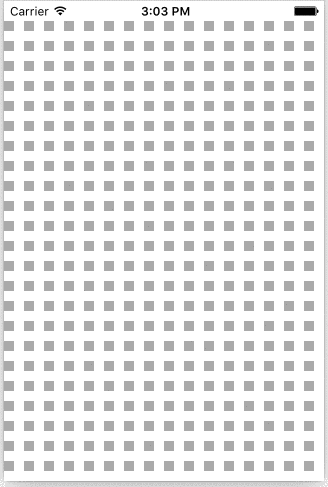I'm attempting to make a UIScrollView only allow zooming in the horizontal direction. The scroll view is setup with a pure autolayout approach. The usual approach is as suggested in a number of Stack Overflow answers (e.g. this one) and other resources. I have successfully used this in apps before autolayout existed. The approach is as follows: in the scroll view's content view, I override setTransform(), and modify the passed in transform to only scale in the x direction:
override var transform: CGAffineTransform {
get { return super.transform }
set {
var t = newValue
t.d = 1.0
super.transform = t
}
}
I also reset the scroll view's content offset so that it doesn't scroll vertically during the zoom:
func scrollViewDidZoom(scrollView: UIScrollView) {
scrollView.contentSize = CGSize(width: scrollView.contentSize.width, height: scrollView.frame.height)
scrollView.contentOffset = CGPoint(x: scrollView.contentOffset.x, y: 0.0)
}
This works very nicely when not using autolayout:
However, when using autolayout, the content offset ends up wrong during zooming. While the content view only scales in the horizontal direction, it moves vertically:
I've put an example project on GitHub (used to make the videos in this question). It contains two storyboards, Main.storyboard, and NoAutolayout.storyboard, which are identical except that Main.storyboard has autolayout turned on while NoAutolayout does not. Switch between them by changing the Main Interface project setting and you can see behavior in both cases.
I'd really rather not switch off autolayout as it solves a number of problems with implementing my UI in a much nicer way than is required with manual layout. Is there a way to keep the vertical content offset correct (that is, zero) during zooming with autolayout?
EDIT: I've added a third storyboard, AutolayoutVariableColumns.storyboard, to the sample project. This adds a text field to change the number of columns in the GridView, which changes its intrinsic content size. This more closely shows the behavior I need in the real app that prompted this question.


Think I figured it out. You need to apply a translation in the transform to offset the centering UIScrollView tries to do while zooming.
Add this to your GridView:
To compute the transform, we need to know the unzoomed height of the view. Here, I'm just grabbing the frame size during layoutSubviews() and assuming it contains the unzoomed height. There are probably some edge cases where that's not correct; might be a better place in the view update cycle to calculate the height, but this is the basic idea.
I'm not sure if this satisfies your requirement of 100% autolayout, but here's one solution, where the
UIScrollViewis set with autolayout andgridViewadded as a subview to it.Your
ViewController.swiftshould look like this:Although @Anna's solution works, UIScrollView provides a way of working with Auto Layout. But because scroll views works a little differently from other views, constraints are interpreted differently too:
So, when you add a subview to the scroll view pinned to its edges/margins, that subview becomes the scroll view's content area or content view.
Apple suggests the following approach in Working with Scroll Views:
In your case, the GridView must be inside the content view:
You can keep the grid view constraints that you have been using but, now, attached to content view. And for the horizontal-only zooming, keep the code exactly as it is. Your
transformoverriding handle it very well.Try setting
translatesAutoresizingMaskIntoConstraintsIn the sample project it works. If this is not sufficient, try creating new constraints programmatically in
scrollViewDidEndZooming:might help.Also, if this does not help, please update the sample project so we can reproduce the problem with variable
intrinsicContentSize()This article by Ole Begemann helped me a lot
How I Learned to Stop Worrying and Love Cocoa Auto Layout
WWDC 2015 video
Mysteries of Auto Layout, Part 1
Mysteries of Auto Layout, Part 2